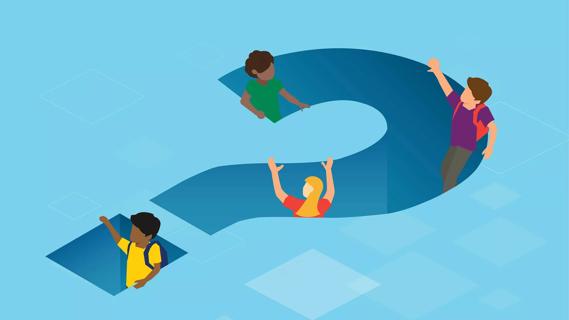This therapeutic game teaches ways to improve attention function

A lot of us have the ability to start and stop tasks suddenly without putting too much thought into it. Sometimes, we may even catch ourselves saying we’re great at multitasking because of our ability to juggle a number of tasks in quick succession. Doing homework, for example, while eating a snack, listening to music and carrying on a conversation through text messages might come easy for some of us.
Advertisement
Cleveland Clinic is a non-profit academic medical center. Advertising on our site helps support our mission. We do not endorse non-Cleveland Clinic products or services. Policy
But if your child is living with attention-deficit/hyperactivity disorder (ADHD), maintaining that level of attention across multiple tasks can be difficult. Some important activities may remain unfinished or overlooked as they struggle to switch between one task and the next. The result? A pile of unfinished homework, spoiled food, dirty dishes and unanswered text messages.
So why, then, are doctors considering a new video game called EndeavorRx™ as a complementary treatment for kids who have ADHD? Aren’t video games, like other media, time-consuming and just another well-placed distraction?
Video games can get a bad rap. And you may fear that too much screen time can be bad for your child’s mental and emotional health. But while it’s true that too much screen time isn’t good for any of us, EndeavorRx was designed specifically for children who have ADHD. The idea is to improve their ability to direct their attention toward specific tasks without them getting distracted along the way.
Pediatric behavioral health specialist Michael Manos, PhD, explains how EndeavorRx works and why video games could be a helpful resource for children with ADHD given the right guidelines.
EndeavorRx is a prescription-only video game designed to improve attention function in children 8 to 12 years old. Although it’s not designed to replace standard ADHD treatment like medications and behavioral therapy, EndeavorRx is the first video game approved by the U.S. Food and Drug Administration (FDA) as a non-drug option for improving symptoms associated with ADHD. These symptoms include inattentiveness, hyperactivity and impulsivity — all of which interfere with a child’s functioning and development.
Advertisement
“ADHD is often considered by some to be a deficit of executive functions,” says Dr. Manos. “Executive functions are considered to be behaviors in the brain. The ability to distinguish between the letter B from the letter D, for example, is an executive function. The ability to organize, the ability to start a task as opposed to resisting a task — there are a number of different executive functions.”
When it comes to executive function, there are two types of attention at play:
“With ADHD, people have difficulty with directed attention,” notes Dr. Manos. “EndeavorRx can improve someone’s ability to sustain focus and it improves a person’s ability to use visual contrast to be able to tell the difference between one thing and another.”
Using EndeavorRx should be treated like any behavioral therapy. By scheduling a set time to engage the treatment and creating a routine, you can help your child improve their attention and focus over the course of several weeks and instill learned behaviors that will help in conjunction with other treatments.
EndeavorRx is for children 8 to 12 years old and requires a prescription from your pediatrician or healthcare provider. Once you have a prescription, you can download EndeavorRx to a compatible device that uses an Android operating system or iPhone operating system. In the app, you can create a profile using your prescription information.
If you don’t have a prescription, you can download a playable demo of EndeavorRx. But understand that the demo is just a tutorial designed to give you a taste of the look and feel of the treatment. The demo doesn’t offer the entire experience and isn’t designed to be used in place of the full experience.
EndeavorRx says that it “uses sensory stimuli and motor challenges to target areas of the brain that play a key role in attention function.” So, what does that look like in practice?
Well, EndeavorRx is a lot like the video game Mario Kart. Your child plays the role of an alien piloting their ship as they explore different worlds. To steer the ship, they tilt the screen in the direction they want the ship to go. As they explore, they’re required to tap the right side of the screen to collect the correct targets that appear while ignoring all other targets.
Advertisement
“It helps with hand-eye coordination and the ability to disseminate one thing from another,” explains Dr. Manos. “You have a figure moving along a path and things come in the way, and you have to click on some of them to get points and avoid others to avoid losing points.”
At the beginning of each mission, your child will be shown a number of possible targets of different shapes and sizes, and they’ll be asked to collect only one type of target. As they steer their way through the course, they’ll need to tap the screen to collect specific targets as they appear while avoiding obstacles and driving through gates and power boost zones.
Successful missions will unlock rewards, outfits and new worlds to explore — but there’s no winning the game. EndeavorRx is designed to adjust gameplay difficulty based on how your child is doing, so if they’re really good at it, the levels will continue to get more and more difficult. And if they’re not so good at it, that’s OK, too. The game will adjust.
So, why play a game you can’t win? Well, the point isn’t to win, it’s to train your brain to improve its focus over time and to instill learned behaviors so your child can focus more intentionally on tasks at hand and reduce the possibility of distraction.
Advertisement
Standard treatment has your child engaging with the game for 25 minutes a day, five days a week. A daily treatment is composed of six to eight missions, depending on how your child plays, and is designed in line with the American Academy of Pediatrics recommendations on screen time for children. Because of this, each daily treatment lasts about 25 minutes without interruption — so, playtime is limited specifically to brain training.
Your child knows they’re done when they’ve completed the required missions for each day or when they’ve run out of in-game fuel to continue. If they haven’t engaged in the treatment, they’ll get display reminders to continue. Plus, as a parent, you can download the companion app EndeavorRx Insight to see how your child is doing, their level of engagement and how they’re improving.
Already, there’ve been several clinical studies involving more than 600 children with ADHD that show how EndeavorRx works to improve attention function. One study showed improved attentional performance after using EndeavorRx over the course of four weeks. Another study showed that using EndeavorRx in conjunction with medication treatment improved ADHD-related impairment over the course of two four-week periods.
Advertisement
There’s a lot that goes into understanding your child’s ADHD diagnosis. The overall goal with treatment is to put into place behavioral interventions so your child can better manage their condition as they continue to learn and grow.
Living with ADHD, your child may need to put organizational systems in place to help them stay on task (think calendar reminders or alarms). They’ll also need to find ways to recognize and understand when they’re restless, inattentive or hyperfocused, and why or how those behaviors can become disruptive in their day-to-day lives. EndeavorRx, while delivered in the form of a video game, can help instill some of these behavioral patterns in small ways in conjunction with other treatments.
But what about other video games? Research into the effects video games have on the brain is varied, but some positive benefits include:
“Positive findings are realized when parents actually sit down and engage the child while they’re playing video games by talking about it, watching it or even playing with their child,” states Dr. Manos. “This can be a very positive experience for parents and kids by turning the game into an interactive experience.”
And the same can be said for EndeavorRx. By checking in with your child over the course of treatment and normalizing the behavior of setting aside time to focus, your child can grow more comfortable with the idea and the associated learned behaviors that come with it.
“When you’re watching a video game, you’ve got to pay attention to every little thing that comes into your visual field and react to it,” says Dr. Manos. “Being able to visually contrast, being able to tell the difference between one thing and another, these are executive functions that some video games can enhance.”
Learn more about our editorial process.
Advertisement

Background stimulation and intentional fidgeting may actually help you stay on task

A booster dose, healthy snack and some downtime may help ward off a medication rebound

Working side by side with another person can improve focus, build accountability and provide motivation to get a task done (or at least started)

The medical condition isn’t a learning disability and doesn’t always cause hyperactivity

There are times and cases when physician-supervised breaks may be beneficial

Using time management tools, adopting new approaches and allowing for a little grace can help meet deadlines and finish tasks

Boys might seem disruptive, while girls might seem inattentive, but ADHD isn’t a sex-specific condition

Both meds have similar benefits and side effects

Babies can get congested easily, but you can calm their cough by keeping them hydrated, using nasal drops and running a humidifier

Weight loss may cause loose, sagging skin and muscle loss to your rear

Several conditions, like vitiligo and fungal infection, can cause a loss of pigmentation, leading to white spots or patches on your skin